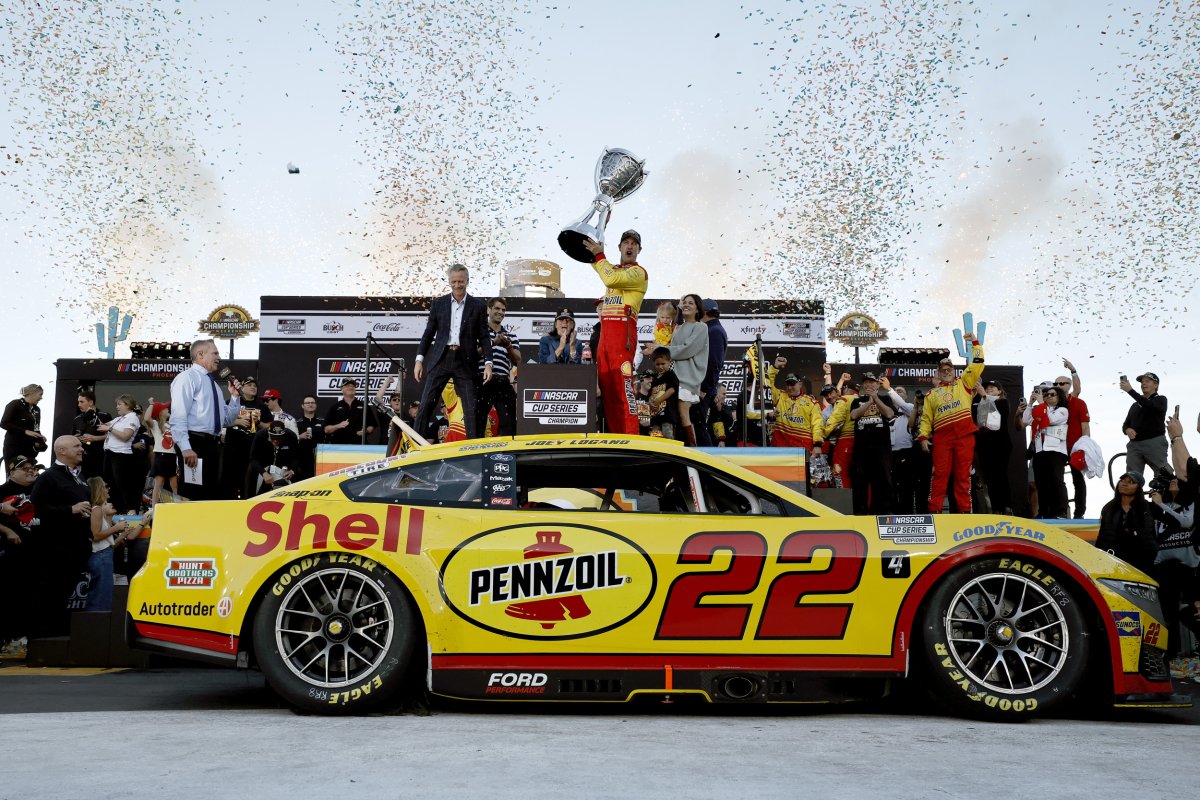The 2024 NASCAR championship has ended with thunderous.. controversy? The newest championship cup to Joey Logano’s trophy cabinet comes with great controversy because of both his generally dismal performance over the year and the failure of the points system. Is the anger deserved?
Logano, through a look at NASCAR’s history and points system, is a beneficiary of a bad system. He took the current scoring format and made it look the worst it ever has and won a hollow victory at stock car racing’s peak.
Ever since he joined NASCAR’s highest echelon of skill, Joey Logano has been a hot prospect. Few doubted his initial raw skill when racing; even as a teen Logano was praised by Mark Martin, a great racer considered one of the best ever to win a Championship. Martin said “he can be one of the greatest that ever raced in NASCAR. I’m positive” (Martin). This is high praise from a great racer; Logano started his racing career in the highest tiers with others like Martin praising him and watching him with great interest. This was shown to be correct as when he joined the secondary series for the Cup Series, the Nationwide Series (The highest level of NASCAR), he won nine races in one year, with many more in the four years after. After he made his way to the Cup Series, success followed soon after. With over a decade and a half to go through, I won’t touch on every one of his achievements but he is an accomplished driver. He has as of today three championships with 36 wins and 285 top ten finishes— with 571 races, that means he has won 6% of every race he has participated in, pretty amazing for NASCAR. The top ten amount also shows that in every race he enters, he has a nearly 50% chance to land himself in the top ten. He is one of the most talented racers in NASCAR. Why would this championship be disputed?
The reason? The NASCAR points system and the “Chase for the Cup” playoffs. For some backstory, in 2004 ratings were dropping and NASCAR, with the Championship victory of Matt Kenseth with a singular win, concluded that there had to be more tension for the championship. 55 years of racing before the 2004 season was based on cumulative points; every race mattered, every position mattered, and any mistake made your chances worse. It was the ultimate example of skill and consistency, in this time champions didn’t have to win, and the path of consistency was king. Then everything changed with the “Chase for the Cup,” which changed enough times that I will only be speaking on the format we are under as of 2017.
How the points system works: Normal Season
The first 26 races of the season are pretty normal, every race you gain regular season points from final placement with weight towards the winner, the winner gaining 5 playoff points. A top-ten placement in one of the first two stages also gaining regular season points. The stages are from beginning to 25% through the race, 25% to 50%, then stage 3 is from 50% to stage end (which is just the result of the race). The top ten gain points descend from 10, while the winner also gains a playoff point. Now what do these points mean? Playoff? Regular season? The regular season is based on the first 26 races and is just the cumulative positionally gained points. Winning the regular season awards the regular season championship with 15 playoff points along with the top ten also receiving playoff points. Now, what is a playoff point? The final 10 races are the playoffs which feature 3 elimination rounds. People qualify for the playoffs through wins, which instantly lock you a spot, and then regular season points determine the final spots that were not gained from wins. Then, the top 16 are in the playoffs; their points are all set to 5000 (It’s an arbitrary number) with their playoff points deciding standing, adding to the 5000. Then we get to the round of 16.
How the points work: Rounds of 16, 12, 8, and the final race
The first round, or round of 16, has 16 racers and 3 races. For the next round, there are 12 spots. You either win to get in, or by points reverting to the regular season points format with points being gained from position. Those who are not in the top 12 when the round ends, are no longer in contention for the championship. The second round, or round of 12, has 12 racers and 3 races, and the third round has only 8 spots— you get in by the same philosophy with a win securing your spot and positional points deciding the rest. The third round is the round of 8, and the final four are chosen, those who can win the championship, same rules as the last. Once the final four drivers are decided, it is a simple race to the finish, the highest placing driver of the final four wins, they can be 2nd, 3rd, or 18th for all that matters as long as they are ahead of the other 3 drivers.
With the rules established, why is this format bad, and what problems does it cause? It rewards risky driving which creates entertainment, but loses expression of skill in racing. In comparison to Formula One, a series that uses points cumulative for the entire season does not have NASCAR’s system cutoff races or a separate point system. The point system promotes extremely clean racing that results in few crashes and a large expression of skill. Not many people have contentions with their championship results. Riya Pharsiyawar, a fan of Formula One and general motorsports enthusiast, talked about her negative experience with the NASCAR rules she knows, saying that a championship “should reward skill and consistency, and having winners like these shows a failure in rewarding those who demonstrate such talent” (Pharsiyawar). People who were eliminated in the second round of playoffs boast better top 5 and top 10 numbers, Logano numbers should never compare to someone who was knocked out of contention a month before the final race. Even someone who enjoys NASCAR regularly, Maya Ramirez, says “Someone who averages 17th should not go far in the Championship fight”(Ramirez), furthering an idea that he should never have had ground to stand on to fight for this championship. He was given a false platform to fight for a championship that should have never been his.
So how did Joey Logano do it? Logano won one race in the regular season at Nashville Motor Speedway keeping him in the playoffs, and won a race in the first round at Atlanta Motor Speedway to keep his tempo going. He floundered in the second round having no wins to his credit averaging a placement of 18th, barely holding on through the second round nearly bringing an end to his playoff run. But after a win in the second race of the third round, he had two weeks to prepare for the final race at Phoenix he was locked in for which he ended up winning. Crucial wins were the only things that kept him in contention, by every metric he was worse than the rest of the field. Because the current point system valued wins over consistency, his awful season led him to hoist the highest trophy in American racing. For some statistical analysis on how bad this season was, throughout the season he averaged an 18th placement finish including the playoffs; in the playoffs he only averaged a 15.3. That is dismal in comparison to other championship runs. On average from 1987 to last year champion Ryan Blaney, there was an average placement of 10.3 from 1987-2023 with the best being 5.9 in 1987 and the worst being 14.9 in 2023 by Logano’s teammate Ryan Blaney. Since the point system changed at this time, if you only take the average placement of when the “Chase for the Cup” was happening, it is still an average of 11.4. Logano, in comparison to the last 39 years, has an abysmal average and in comparison to the last 20, it still is not deservant of the trophy.
It becomes clear that Joey Logano, throughout his season, truly should have never been considered for the championship come the last third of the year, probably earlier. As a result of a flawed point system that weighs too heavily on wins he managed it, making him, in my opinion, the most undeserving champion in the last 40 years of racing.





























